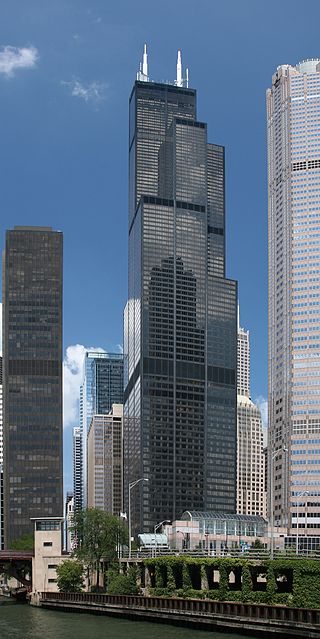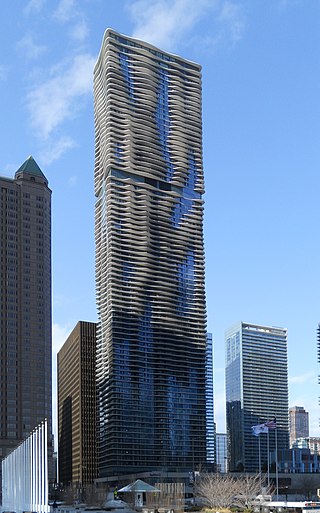Related Research Articles

Louis Henry Sullivan was an American architect, and has been called a "father of skyscrapers" and "father of modernism". He was an influential architect of the Chicago School, a mentor to Frank Lloyd Wright, and an inspiration to the Chicago group of architects who have come to be known as the Prairie School. Along with Wright and Henry Hobson Richardson, Sullivan is one of "the recognized trinity of American architecture". The phrase "form follows function" is attributed to him, although he credited the concept to ancient Roman architect Vitruvius. In 1944, Sullivan was the second architect to posthumously receive the AIA Gold Medal.

The American Institute of Architects (AIA) is a professional organization for architects in the United States. Headquartered in Washington, D.C., the AIA offers education, government advocacy, community redevelopment, and public outreach to support the architecture profession and improve its public image. The AIA also works with other members of the design and construction community to help coordinate the building industry.

The buildings and architecture of Chicago reflect the city's history and multicultural heritage, featuring prominent buildings in a variety of styles. Most structures downtown were destroyed by the Great Chicago Fire in 1871.

Richard Stanley Nickel was a Polish American architectural photographer and historical preservationist, who was based in Chicago, Illinois. He is best known for his efforts to preserve and document the buildings of architect Louis Sullivan, and the work of the architecture firm of Adler & Sullivan.

Harry Mohr Weese was an American architect who had an important role in 20th century modernism and historic preservation. His brother, Ben Weese, is also a renowned architect.
Fellow of the American Institute of Architects (FAIA) is a postnominal title or membership, designating an individual who has been named a fellow of the American Institute of Architects (AIA).

The Sullivan Center, formerly known as the Carson, Pirie, Scott and Company Building or Carson, Pirie, Scott and Company Store, is a commercial building at 1 South State Street at the corner of East Madison Street in Chicago, Illinois. Louis Sullivan designed it for the retail firm Schlesinger & Mayer in 1899 and later expanded it before H.G. Selfridge & Co. purchased the structure in 1904. That firm occupied the structure for only a matter of weeks before it sold the building to Otto Young, who then leased it to Carson Pirie Scott for $7,000 per month, which occupied the building for more than a century until 2006. Subsequent additions were completed by Daniel Burnham in 1906 and Holabird & Root in 1961.
Robert Sharoff is a Chicago-based architectural writer and author. He has written for a variety of publications including the New York Times, the Washington Post, the Chicago Tribune, and Chicago Magazine. He frequently collaborates with photographer William Zbaren.
Richard Herman Driehaus was an American fund manager, businessman and philanthropist. He was the founder, chief investment officer, and chairman of Driehaus Capital Management LLC, based in Chicago.

Aqua is an 82-story mixed-use skyscraper in Lakeshore East, downtown Chicago, Illinois. Designed by a team led by Jeanne Gang of Studio Gang Architects, with James Loewenberg of Loewenberg & Associates as the Architect of Record, it includes five levels of parking below ground. The building's eighty-story, 140,000 sq ft (13,000 m2) base is topped by a 82,550 sq ft (7,669 m2) terrace with gardens, gazebos, pools, hot tubs, a walking/running track and a fire pit. Each floor covers approximately 16,000 sq ft (1,500 m2).
Eric J. Hill, Ph.D., FAIA, is a Professor of Practice in Architecture at the University of Michigan. He earned his bachelor's degree in Architecture in 1970 from the University of Pennsylvania, a Masters in Architecture from Harvard in 1972, and a Ph.D in Architecture from the University of Pennsylvania in 1976. He was a Marshall Research Fellow at Denmark's Royal Academy of Fine Arts from 1972 to 1973. He is the co-author, along with John Gallagher, of AIA Detroit: The American Institute of Architects Guide to Detroit Architecture. He has served as a Director of Urban Planning and Design at the Detroit firm of Albert Kahn Associates. He has participated in projects such as the promenade on the Detroit International Riverfront, the Detroit Opera House restoration, and the Cadillac Place redevelopment. He has received numerous awards from the American Institute of Architects.
Joseph M. Siry is a leading American architectural historian and professor in the Department of Art and Art History at Wesleyan University. Siry's publications have focused particularly on the architecture of Louis Sullivan, Frank Lloyd Wright and the Prairie School.

Thomas Roszak is an American architect, real estate developer, business executive, author, and academic.
David Woodhouse is an American architect born in Peoria, Illinois. He is the founder of David Woodhouse Architects, now Woodhouse Tinucci Architects.

Paul Florian is the lead designer at Florian Architects, an architecture firm based in Chicago. Florian’s portfolio includes the renovation of the landmark Hyde Park-Kenwood National Bank Building, retail prototypes and nationwide roll-outs for H2O Plus, Cellular One, and United Audio Centers (Tweeter), retail stores and showrooms for Sotheby’s, Chiasso, and Oilily, museum exhibits for the Art Institute of Chicago and the Museum of Science and Industry, and numerous single- and multi- family residences.

Peter Exley is the co-founder of Architecture Is Fun, a Chicago-based architecture and design firm. Exley’s projects include the DuPage Children’s Museum, the House in the Woods, a 21,000-square-foot (1,950m2) Ronald McDonald House in Oak Lawn, Illinois, the Exploration Station children's museum and the Young at Art Museum's exhibits and galleries in Davie, Florida.

Carol Ross Barney is an American architect and the founder and Design Principal of Ross Barney Architects. She is the 2023 winner of the AIA Gold Medal. She became the first woman to design a federal building when commissioned as architect for the Oklahoma City Federal Building, which replaced the bombed Alfred P. Murrah Federal Building. Ross Barney's other projects include the JRC Synagogue, James I Swenson Civil Engineering Building, the CTA Morgan Street Station, and the Chicago Riverwalk.

Martin Felsen is an American architect and Fellow of the American Institute of Architects (FAIA). He directs UrbanLab, a Chicago-based architecture and urban design firm. Felsen's projects range in scale from houses such as the Hennepin, Illinois Residence, mixed-use residential and commercial buildings such as Upton's Naturals Headquarters, public open spaces such as the Smart Museum of Art Courtyard at the University of Chicago, and large scale, urban design projects such as Growing Water in Chicago and a masterplan for the Yangming Lake region of Changde, China. Felsen was awarded the 2009 Latrobe Prize by the American Institute of Architects, College of Fellows.
Ross Barney Architects is an architectural firm founded in 1981 by Carol Ross Barney in Chicago, Illinois.
Edward John "Tim" Seibert was an architect based in Sarasota, Florida. Seibert was a Fellow of the American Institute of Architects and one of the founders of the modern movement known as the Sarasota School of Architecture.
References
- 1 2 Brott, Jody (October 29, 1989). "COMMERCIAL PROPERTY: The Capone Connection; Transforming a Onetime Chicago Mob Headquarters". The New York Times.
- 1 2 Sjostrom, Joseph (August 15, 1979). "Carsons Unveils Rotunda". The Chicago Tribune.
- ↑ "John Vinci, The Modern Preservationist". October 8, 2014.
- ↑ Sharoff and Zbaren, Robert, William (2017). John Vinci: Life and Landmarks. United States: Northwestern University Press. ISBN 978-0810136656.
- 1 2 Kaman, Blair (December 23, 2014). "Chicagoans of the Year in Architecture: John Vinci and Philip Hamp". The Chicago Tribune.
- 1 2 3 4 5 6 "JOHN VINCI, FAIA, TO BE AWARDED AIA CHICAGO'S 2014 LIFETIME ACHIEVEMENT AWARD". aiachicago.org. June 20, 2014.
- 1 2 "JOHN VINCI, FAIA, TO BE AWARDED AIA CHICAGO'S 2014 LIFETIME ACHIEVEMENT AWARD". aiachicago.org. June 20, 2014.
- ↑ "John Vinci to receive AIA Chicago 2014 Lifetime Achievement Award, even as his indispensable Adler and Sullivan book still out of print". chicagomag.com. June 24, 2014.
- ↑ Walker, Cassie (February 4, 2011). "The Complete Architecture of Adler and Sullivan,' by Richard Nickel and Aaron Siskind". Chicago Magazine.
- ↑ Pridmore, Jay (April 16, 1989). "Garden of Bronze". The Chicago Tribune. Retrieved August 14, 2017.
- ↑ "John Vinci Papers, Ryerson and Burnham Archives, The Art Institute of Chicago". SAIC Digital Libraries. Box FF 6.9.
- ↑ Goldberger, Paul (August 16, 1987). "ARCHETECTURE [sic] VIEW; SAVING A MUSEUM'S BEAUX-ARTS PAST ..." The New York Times.
- ↑ Obscura, Atlas Contributor (January 17, 2017). "This Historic Trading Room Was Taken Apart and Rebuilt Piece by Piece". Slate.com.
{{cite web}}:|first=has generic name (help) - ↑ Goldberger, Paul (April 7, 1977). "A Sullivan Room Is Recreated in Chicago". The New York Times.
- ↑ Blair, Gwenda (November 6, 2003). "In Traditional Chicago, The Politics of Fitting In". The New York Times.
- ↑ Sierzputowski, Kate (April 30, 2015). "A Witty Conversation Between Art and Architecture". hyperallergic.com.
- ↑ Kamin, Blair (December 23, 2014). "Chicagoans of the Year in Architecture: John Vinci and Philip Hamp". The Chicago Tribune.
- ↑ "John Vinci Papers, Ryerson and Burnham Archives, The Art Institute of Chicago". The Art Institute of Chicago Library Archives.
- ↑ DEMIRJIAN, Leah (October 27, 2014). "AIA Chicago Reveals Design Excellence Award Winners at Designight 2014". ArchitectMagazine.com.
- ↑ "2011 Legendary Landmark John Vinci" (PDF). Landmarks.org. 2011.
- ↑ Gapp, Paul (November 3, 1981). "Designs of Distinction". The Chicago Tribune.
- 1 2 "Twelfth Night Gala Set Sunday". The Chicago Tribune. January 1, 1981.